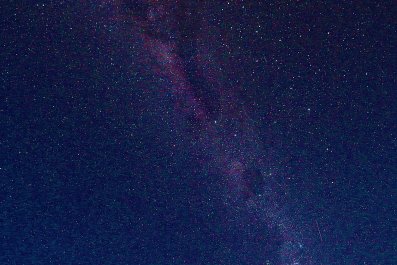Back in the 1970s, scientists at Ohio State University began searching for signs of intelligent alien life using a radio telescope the size of three football fields. Like a giant car antenna, it listened for broadcasts from space and dumped the data onto a one-megabyte (about 1/1000th of a gigabyte) hard drive, about the capacity of an old floppy disk. They called it the Big Ear.
One day, in the summer of 1977, a Big Ear scientist named Jerry Ehman began reading through three or four days' worth of data printouts. Something caught his eye – a narrowband signal 30 times stronger than the standard white noise of space. It was just what they were looking for: a big, eerie beep from somewhere way out there. Ehman circled the code sequence and jotted a short annotation: "Wow!"
Despite its blockbuster movie connotations, the search for extraterrestrial intelligence or Seti, is a serious endeavour for astronomers. Curiosity about far-flung organisms has fuelled the race to find planets like Earth in other solar systems, water on Mars and, for radio astronomers, the first space-borne broadcast. To date, however, every possible sign of extraterrestrial intelligent life has been scientifically explained away.
That "Wow!" signal, as it came to be known, turned out to be a solitary event that still eludes explanation. After its discovery, Ehman and others aimed their radio telescopes back at the source, in the constellation Sagittarius, to see if they could hear more. In the world of radio Seti, one signal is an anomaly; two signals, if they're identical, is an alien. In this case, there wasn't another peep.
But the episode made one thing clear: one megabyte scrutinised by hand every few days wasn't going to cut it.
Ohio State scrapped the Big Ear in 1998. The next year, scientists at the University of California, Berkeley, launched a project called seti@home. They wanted to analyse the data that streams into Arecibo Observatory in Puerto Rico – tens of millions of megabytes – so they developed a software program that runs as a screensaver on the home computers of anybody who wants to download it. More than 6 million have. "We're accumulating a giant database of candidate signals, bursts of energy at a particular frequency that occurred at a particular time," says David P Anderson, a computer scientist who directs seti@home.
Radio waves, like x-rays or visible light, are a form of electromagnetic radiation. Things in space, including stars and galaxies, emit this energy naturally, and astronomers have used that information to build maps of the universe. For Seti, scientists don't look for encoded radio transmissions because the signal would be too spread out and it would just look like noise. Instead, they look for spikes in the intensity of signals and deliberate patterns in those spikes.
They always tune their dials around a single frequency, 1420 megahertz – the frequency at which hydrogen atoms emit their energy. It's a clever move: hydrogen is the most abundant element in the universe, something any carbon-based life-form would also know. Here on Earth, broadcasters and governments have been asked by the International Astronomical Union not to use that frequency lest they interfere with a cosmic conversation.
Anderson's database of "candidate signals" that occupies two-thirds of a one-petabyte server at Berkeley, is full of information about spikes picked up by the Arecibo Observatory. One petabyte is 1 million gigabytes and can hold about as much information as a 250-billion-page book. Anderson and his colleagues must now find a way to read it, using algorithms that can sort the signals into groups: natural phenomena, Earth-generated interference and – just maybe – first contact.
But the Seti community's Big Data problem is about to get even bigger. The Green Bank Telescope in West Virginia and the Low Frequency Array (Lofar) in the Netherlands are two other radio telescopes constantly downloading data from the sky. A third, called the Square Kilometre Array, or SKA, will be the biggest radio telescope in the world when it's completed in 2025. Located in both South Africa and Australia, SKA will be able to scan massive swathes of space, and Seti is to be one of its main missions.
Michael Garrett directs the Dutch organisation that runs the Lofar telescope and is a key figure in the SKA planning. "Intelligent life is probably relatively rare," he says, "and so to find it you have to survey a large fraction of the sky. And you have to be able to do that very quickly."
That's why he is one of the leading proponents of incorporating commercial advances in big data for Seti, including storage, analytics and visualisation. Companies like Facebook, Google and Amazon have invested more in big data strategies than science ever will. Garrett believes astronomers must appropriate that capacity. The next step, he says, is "bringing cognitive computing into astronomy, so you actually have the computers themselves learning about astronomy and making discoveries on their own".
In the meantime, the scientists can't help but wonder what a Seti discovery would be like. Garrett notes that any alien signal is likely to be a bending frequency, a Doppler effect caused by the movement of our planets or their spaceship. Anderson says he hopes it will somehow deliver the key to a galactic internet – maybe all sorts of intelligent life-forms are already connected by a kind of Milky Way Wide Web, and Earth is late to the party.
If anybody knows something about that thrill of discovery, it's Ehman, the Ohio State "Wow!" scientist. Since 1977, scientists have heard plenty of spikes like that one, but always there's been a man-made explanation. The "Wow!" signal is one of a kind: an extensive review of terrestrial and natural possibilities for it ruled out everything, from military experiments to black holes. But they never heard it again. "Of course," he says, "that doesn't mean it wasn't a signal from an intelligent civilisation."
Ehman, now 74, says that as our technology improves, our chances of finding something grow. "All we can do is observe with what equipment we have. Who knows? Maybe they're modulating gravity waves, for all we know."
What Ehman means is that maybe we aren't advanced enough to read or even recognise their communication technology. "We're a young civilisation, so we presume that other civilisations are millions of years ahead of us in terms of time that they've existed. Who knows what can be developed in a million or 10 million years?"






























